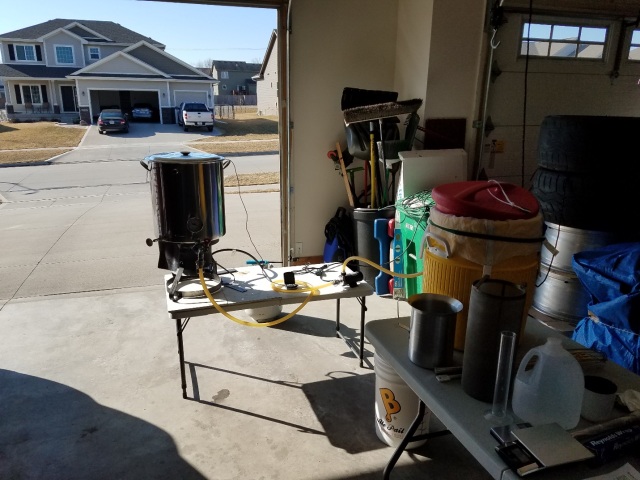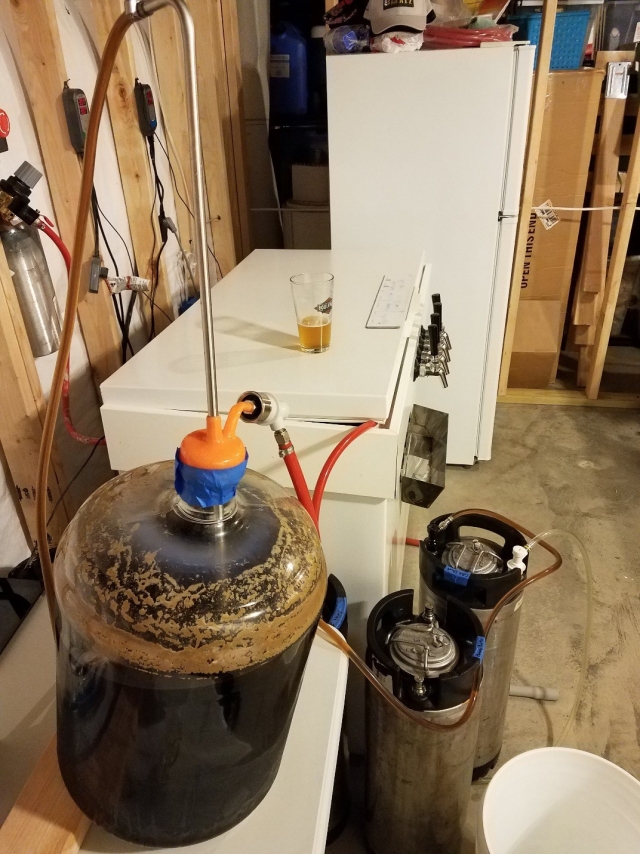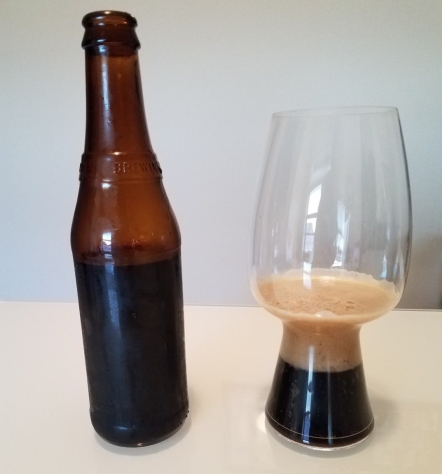This post is one in a series following six brewers collaborating to each make a small adjustment to a single recipe in order to improve it, then pass it along to the next brewer. We hope to learn more about the art of recipe creation as we see how other brewers approach the same recipe. The rest of the series can be found here.
Author: M. Willis
Brew Day
My brew day starts a few days before I actually brew when I finalize the recipe in Beersmith, decide on my water adjustments via Bru’n Water, and then acquire the ingredients from the local homebrew store. My LHBS has been such a big part of my happiness as a brewer. The owners are super fun, very knowledgeable, and a huge part of our local brew club. Everyone deserves a great LHBS. It makes the hobby way more fun!
My equipment is atypical. I do not use either a 3-vessel system or Brew in a Bag (BIAB). I use the less common Mash in a Bag (MIAB) method, using a 10-gallon cooler—the reason being, most of the time I batch sparge because I find it more repeatable and there’s something comforting about stable mash temps. I then boil in a 15-gallon kettle. I’ve been using this equipment and methods for several years, so this brew day was entirely without surprise. How very Zen.
I collect and treat my local water with Campden tablets the night before I brew. We are lucky to have access to the water company’s current test results via their website, so I’m fortunate to have enough info for adding my water salts. I have a puppy who is learning about homebrewing. She started by just watching my water gathering but couldn’t stay away from the interesting smells of the brew salts on the counter, so she was ushered into the basement while I re-cleaned the counter and prepped the salts for brew day. I then stepped out to the driveway to mill my grains. Owning a mill has helped with repeatability.
The next morning, I set up in the garage with the burner next to the open garage door. From left to right and following the hoses, we have a turkey fryer, a 15-gallon kettle with a Quick Clean Take-Apart Ball Valve which allows complete cleaning & inspection each brew day, silicon hoses to a Topsflow Brewing Pump, then my cooler Mash Tun with a brew bag. Next are my hand tools; gallon stainless pitcher, hop filter for the kettle, comically large whisk, plastic mash paddle, scales, and so on.

I heated my water, added salts, transferred to the mash tun, checked the temperature, mashed in, and checked the temp again. As I mentioned before, I’ve been using the same equipment and methods for quite a long time, so I usually hit my temps and volumes—if I don’t, it’s because I’ve entered something wrong in Beersmith. I hit my target mash temp of 157°F. You may recall the other iterations used a 154-155°F actual mash temp, and I admit my target was based on the target for Iteration 2 and not the actual temp. Well, recent tests have shown a few degrees (even 14°F) might not matter, right? Maybe.
60 minutes later, I raised the bag to drain, and then transferred into my kettle. A quick sparge, and that went into the kettle too. I again hit my numbers, with the pre-boil gravity at 1.055 after adjusting for the temperature.
I boiled, adding hops at 60 minutes and 5 minutes as planned, then chilled to 61°F. My groundwater is COLD right now so I overshot a bit during chilling. I took a gravity reading, and I’d hit the mark again at 1.065 (after temp correction). The wort was transferred to a 6-gallon plastic carboy using a short piece of silicone hose and Siphon Spray Wort Aerator. The fermenter was then moved to my dedicated fermentation fridge, I set my Inkbird temp controller for 64°F (cooling only), and I tempted fate with a 3-piece airlock rather than blow-off hose. I correctly guessed that I had enough headspace….this time. An hour later when the foam subsided, I added a single packet of Safale US-05.
I don’t use a heater, because usually my heated basement and an active fermentation cooperate. However, this beer was sluggish to start. I had overchilled, so I propped open the fridge door and covered the fermenter with a t-shirt to prevent any skunking from sunlight. The yeast finally got to work after 48 hours. I turned the cooling off on the controller but set a high temp alarm just in case. I then warmed the beer slowly to 68°F over the course of about 7 days. I held it there for 3 more days and took gravity readings two days apart. The final gravity was stable at 1.020, which at 68% attenuation, is quite low for US-05. Either way, I cold crashed and kegged.
I make a lot of NEIPAs, so I use low O2 methods after fermentation. I fill a keg completely to the top with sanitizer and then push it all out with CO2. The beer is then pushed from the fermenter to the keg with CO2. I, like others, noticed enough difference to continue doing it this way. My carbonating process is either the set-it-and-forget-it at serving pressure method or, if I’m in a hurry, it gets cranked to 40+psi and shaken. I did the latter on this beer since we’re moving quickly to get you the next episode in this adventure as fast as possible.
Unfortunately, I over-carbed for the first time and I needed to get samples to the next brewer ASAP. I commenced venting a few times a day and my first attempt at bottling ended up a failure of foam, half full bottles, and sticky hands. Finally, the repeated venting worked and I was able to fill bottles using my counter-pressure setup.

Recipe
Maybe I’m sensitive to the higher Lovibond Chocolate used in the last iteration. Maybe the combo with 10% roasted barley pushed my buttons. Maybe the beer was young and just expressing differently than it would have if this stout were aged another month. I had not yet seen the recipe at the time of tasting, but I thought this beer likely had a significant percentage of high Lovibond grains in the grist. The positives were that it had a great aroma, but this was followed by flavors and mouthfeel I didn’t care for as described below.

Appearance: Inky black, light-tan head that starts fluffy but fades to nothing
Aroma: Coffee, roasted malts, and chocolate that increase as the beer warms. There’s a lot happening. My 8-year-old daughter smelled it and immediately said sushi. She then clarified by saying soy sauce. So, umami? Maybe. I get that sometimes on aged stouts and it might be on the edges here. Kids have a much stronger sense of smell. Umami is certainly not high in this one to me. We’ll have to play What Do You Smell next time I open another stout.
Flavor: High amounts of coffee and roast followed by bittersweet chocolate. When cold there is a pronounced dry finish with light burnt malt flavor and no esters. Hops get lost behind the other flavors or perhaps are too complimentary to stand up and be noticed. Once the beer warms the roast malt flavor becomes prominent and malt sweetness joins the party.
Mouthfeel: The nose would have you anticipate something thicker, but this beer is very light bodied for the style. There is a black tea astringency to me, medium high carbonation, no alcohol warmth.
Comments: Bold like a dark roasted coffee served black. It gets better as it warms. It’s too bad the parting shot of this beer is the puckering sensation of the black tea astringency. That’s not to say I would score this low. Interestingly enough, I could see this as a base for a Black IPA.
Changes: I’d like to fix that black tea astringency. You’re left with that taste and sensation to ponder over between sips, which is too bad because there’s so many other great flavors in there too. Once the malt bill is dialed in, I’d play with more expressive yeasts and more flavorful American hops. This is a beer I’d have a hard time making one change at a time if I weren’t using this iterative process.
This tasting really pushed me out of the zone I thought I’d be in. I figured I’d make one small tweak, but I ended up asking how far I could go with my “one” change. I was surprisingly given more room than I had allowed myself. [Editor’s note: We discussed this change, and since there was an unintentional change in maltsters for the chocolate malt between batches, resulting in a change of around 300°L in Iteration 2 to 500°L in Iteration 3, I decided that moving back to the 300°L shouldn’t be considered part of this change. Efforts to return to the target OG and/or a more appropriate OG for the style were also not considered as outside of the realm of change that would be appropriate due to similar corrections made between certain versions of my red IPA.]
I read and reread the intent for this beer, and after bouncing ideas off my guy at the LHBS, I came to a decision. I added flaked barley and adjusted the other grain amounts to rebalance. My desire was for the flaked barley to add some body, flavor that blends nicely with roast barley, and head retention.
- Mashed at 157° for 60 minutes
- 72.5% 2-row
- 10.8% Victory
- 7.8% Flaked Barley
- 4.4% Roasted Barley
- 4.4% Pale Chocolate (300°L)
- Boiled for 60 minutes
- 0.89oz Nugget (60 min.) at 14.0% AA (41.2 IBUs)
- 1 oz Willamette (5 min.) at 4.8% AA (3 IBUs)
- Pitched Safale US-05 at 61°
- OG: 1.065
- Target FG: 1.018
- Actual FG: 1.020
- ABV: 5.9%
- Kegged after FG was stable
- Cold crashed for a day
- Closed transfer with CO2 into a purged keg
- Carbonated by cranking it to 40psi, then rock & roll the keg to help start absorption
- Disaster: I discovered on I had over-carbed a beer for the first time using this method. I then commenced venting the keg a few times a day so I could bottle.
- After a lot of venting and an aborted attempt (picture a Science Fair volcano), I was able to bottle samples using counter-pressure four days after kegging.
Tasting
I accomplished most of what I intended with the flavor, aroma, and mouthfeel. This beer is balanced and gets better as it warms. There is no longer a parting shot of puckering sensation of the black tea astringency. I’m smelling and tasting, chocolate, coffee, and a dark sweet cherry note. I’m comfortable with this beer, which in my opinion is a good quality in a stout. With a final gravity of 1.020, this is the kind of beer that coats your tongue so there’s a lot to ponder between sips. It also leaves significant lacing on the glass, which provides ample aroma each time you bring the glass to your mouth and nose.
I’ve never been a big fan of the neutral, workhorse we call US-05. When I brew this again (and I will outside this blog experiment) I would like a more expressive yeast: Denny’s Favorite WY1450 or London Ale WLP013 spring to mind. I am quite interested to see where the next brewer takes this!
Recipe Progression
| Iteration 1 | Iteration 2 | Iteration 3 | Iteration 4 | |
| Base Malt 2-row | 80% | 80% | 80% | 72.5% |
| Specialty Malt 1 | 10% Victory | 10% Victory | 5% Victory | 10.8% |
| Specialty Malt 2 | 5% Roasted Barley | 5% Roasted Barley | 10% Roasted Barley | 4.4% Roasted Barley |
| Specialty Malt 3 | 5% Carafa III | 5% Chocolate Malt | 5 % Chocolate Malt | 4.4% Chocolate Malt |
| Specialty Malt 4 | None | None | None | 7.8% Flaked Barley |
| 60 min. hop | Nugget: 47.7 IBUs | Nugget: 42.5 IBUs | Nugget: 47.7 IBUs | Nugget: 41.2 IBUs |
| 5 min. hop | Willamette: 3.6 IBUs | Willamette: 3.3 IBUs | Willamette: 2.9 IBUs | Willamette: 3 IBUs |
| Yeast | US-05 | US-05 | US-05 | US-05 |
| OG | 1.054 | 1.060 | 1.045 | 1.065 |
| FG | 1.010 | 1.016 | 1.005 | 10.20 |
| ABV | 5.8% | 5.8% | 5.25% | 5.9% |

Pingback: Tasting Iterations 3 & 4 | brewublog
Pingback: Stout: Iteration 5 | brewublog
Pingback: Stout: Tasting Iterations 4 & 5 | brewublog
Pingback: Stout: Iteration 10 | brewublog
Pingback: Stout: Tasting Iterations 9 & 10 | brewublog